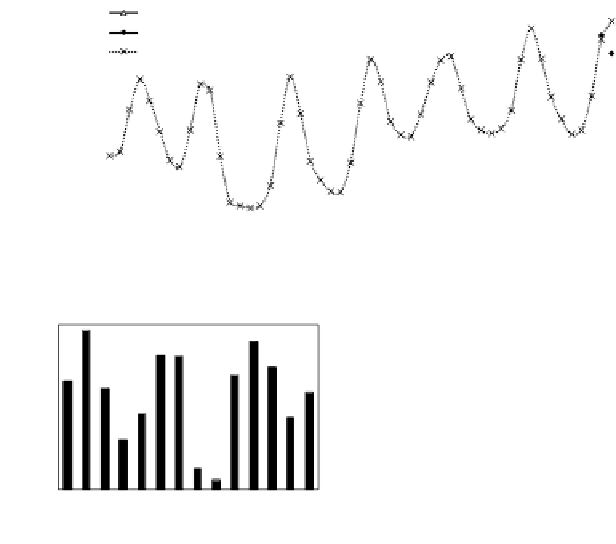Environmental Engineering Reference
In-Depth Information
[
SO
4
2
−
] (slope = −0.61,
r
= 0.70,
n
= 48,
p
< 0.001) and log [
NH
4
+
] (slope = −0.56,
r
= 0.65,
n
= 48,
p
< 0.001). Good negative correlations indicate that the gas-to-
particle sorption has occurred, and the slopes below −1 suggest that the sorption
equilibrium has not reached yet. These results suggest that gas-particle partitioning
of organic acid depends not only on physical and chemical characteristics of organic
acid (vapor pressure, water solubility, Henry's law constant, acidity constant, etc.),
but also on compositions in aerosols, such as water content (to affect aerosol
hygroscopic), ammonium (to affect aerosol acidity and ammonium salt formation),
and sulfate (to affect secondary particle formation).
2500
8.0
Gas
Particle
OOA
7.0
2000
6.0
5.0
1500
4.0
1000
3.0
2.0
500
1.0
0
0.0
7-29
7-30
7-31
8-1
8-2
8-3
8-4
8-5
Date
Fig. 1.
Temporal variation of gaseous and particulate concentrations of total organic acids
Ga s
Pa rt icle
0.0
100%
y
= -0.68
x
-0.09
r
= 0.73,
n
= 48,
p
< 0.001
-0.4
80%
-0.8
60%
-1.2
40%
-1.6
20%
0%
-2.0
0.6
0.8
1.0
1.2
1.4
1.6
1.8
2.0
Log [
water content
]
Fig. 2.
Gas-particle partitioning of individual
organic acid during July 29−August 4, 2008
Fig. 3.
Correlation between log [
K
p] and log
[
water content
];
K
p = [
P
]/([
G
]*[
water content
])
References
Abbatt, J.P.D., Broekhuizen, K., Pradeep Kumar, P. (2005). Cloud condensation nucleus activity of
internally mixed ammonium sulfate/organic acid aerosol particles.
Atmospheric Environment
,
39
, 4767-4778.
Hagino, H., Takada, T., Kunimi, H., Sakamoto, K. (2007). Characterization and source
presumption of wintertime submicron organic aerosols at Saitama, Japan, using the Aerodyne
aerosol mass spectrometer.
Atmospheric Environment
,
41
, 8834-8845.

























































































